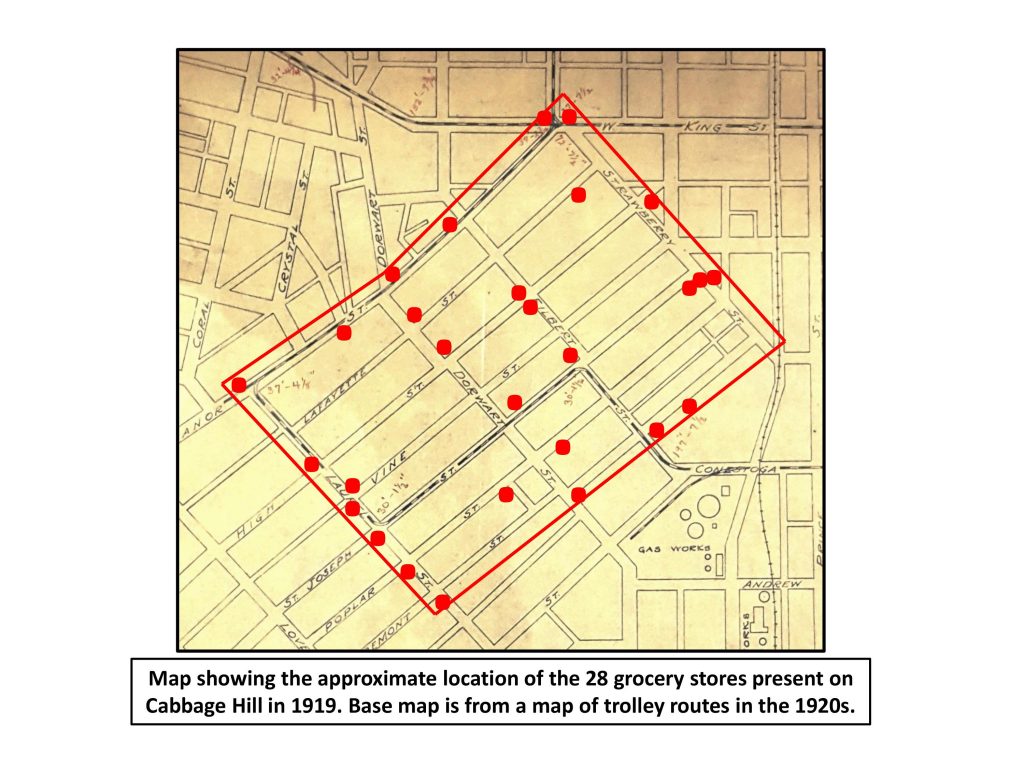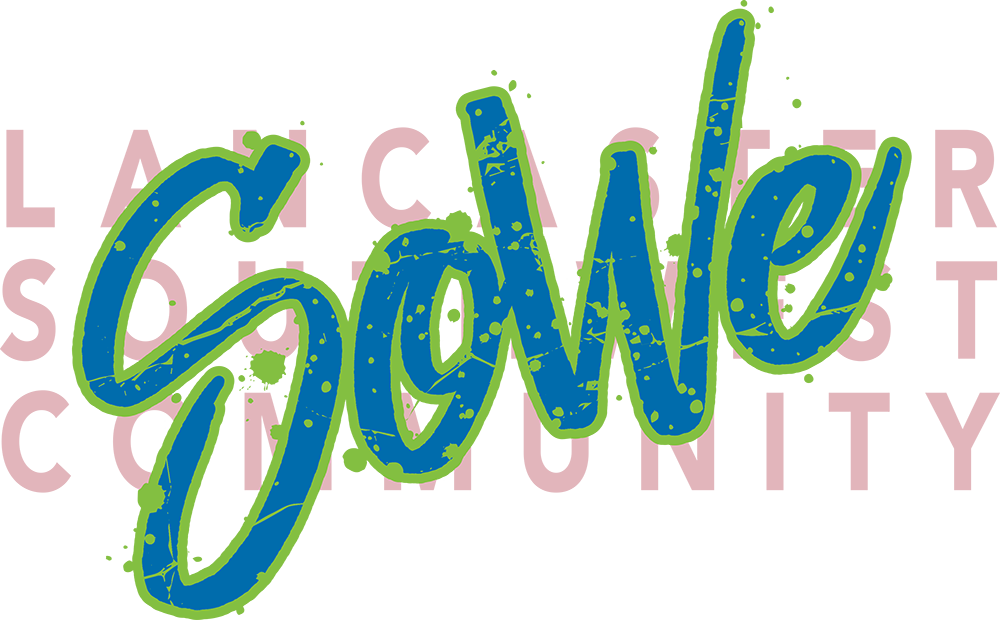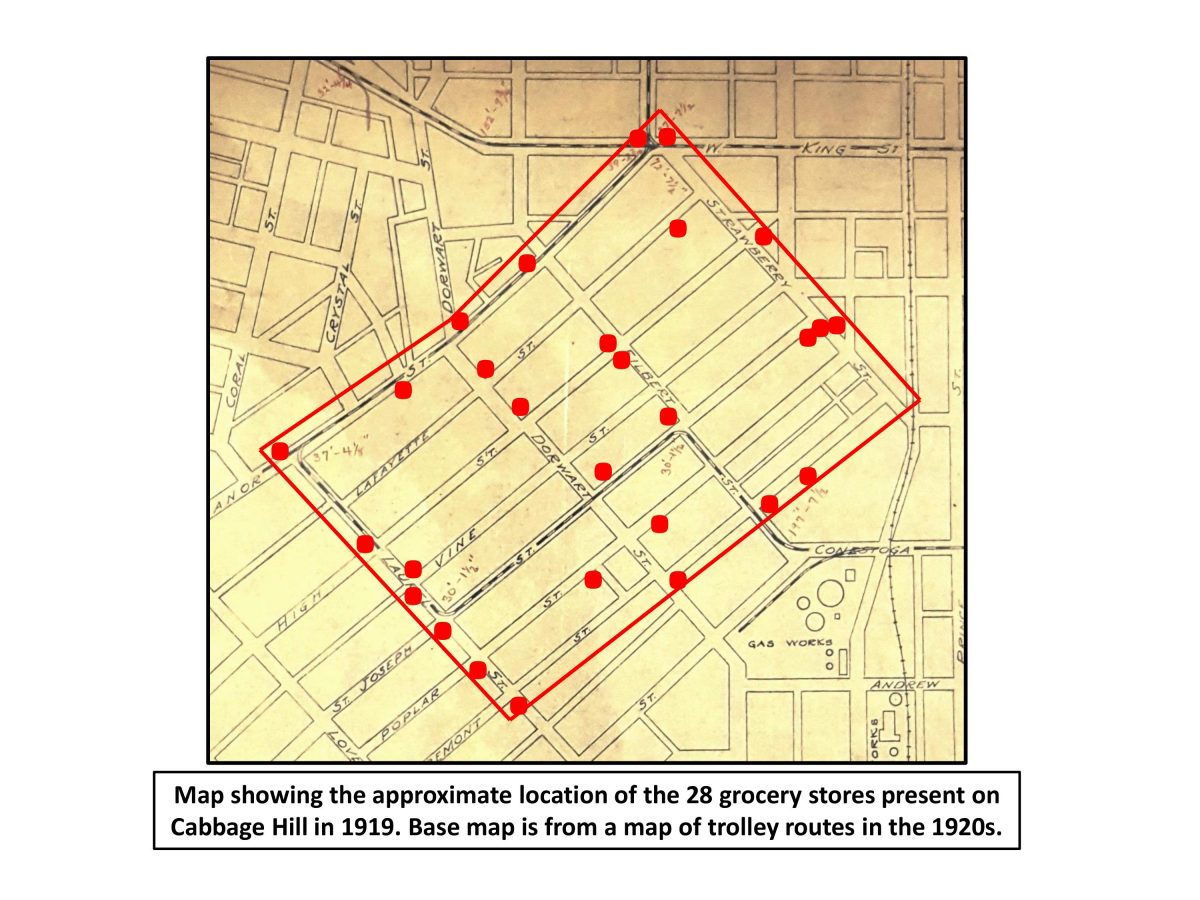Jim Gerhart
July,2019
In 1919, things were generally looking up in the U.S.—World War I had just ended, unemployment was nearly negligible, and women finally were getting the right to vote. On the other hand, the Spanish flu pandemic made a comeback, and the Ku Klux Klan continued to stoke fear in many states. And, for better or worse, depending on your point of view, the 18th Amendment (Prohibition) went into effect. In the midst of these national events, Cabbage Hill was beginning to recover from the anti-German sentiment brought on by the war. As part of that recovery, the Hill was definitely “open for business”.
Ever since its first neighborhood was established in 1762 on Manor and High Streets, Cabbage Hill has been home to enterprising residents who have operated their own local businesses. In the late 18th and early 19th centuries, these businesses provided necessary subsistence services that reflected the trade skills of its mostly German immigrants. Blacksmith, shoemaker, carpenter, and butcher shops were common local businesses.
During the late 19thcentury, Cabbage Hill businesses continued to evolve with the times, and businesses such as bakeries, barber shops, tailor shops, cigar factories, and grocery stores were common. A community of immigrants that often felt somewhat separate from the main part of Lancaster, the Hill seemed to have at least one of every type of business, allowing it to get along without depending too much on the rest of the city.
In the early years of the 20th century, continuing technological change led to another gradual shift in the types of businesses on the Hill, but the businesses still offered nearly every possible desired service no more than a couple blocks away. The businesses continued to provide what the residents needed and wanted, but they also embraced new technologies. For example, one might find a car repair shop around the corner from a blacksmith shop, or a new movie theater on the same block as an old beer saloon.
The year 1919 was typical of this evolving business environment on the Hill, as the following paragraphs will show. But first, let me define what I mean by “the Hill”. For this discussion, I focused on what many consider the historic core of Cabbage Hill, that is, the area bounded by Manor on the northwest, West Strawberry on the northeast, Fremont on the southeast, and Laurel on the southwest. Defined this way, the Hill contains seven main streets running northeast-southwest, and four main streets crossing those seven in a northwest-southeast direction, resulting in 21 blocks and 28 intersections.
The 1919 directory for Lancaster City advertised 125 businesses in the 21 blocks of the Hill. They ranged from the small scale (a nurse operating from her house) to the large scale (Follmer-Clogg Silk Mill). Most of the businesses (32) were on Manor, but High, West Vine, St. Joseph, and Poplar each had about 15 businesses. Fifty-eight of the 125 businesses were located on a corner of one of the 28 intersections. Nearly every business was owner-operated, and nearly every business owner lived in or next to his/her place of business.
All the major types of businesses were found in multiple locations on the Hill. Amazingly, there were 28 grocery stores (see map), more than one per block on average. The Hill also had six hotels, six meat markets, five bakeries, five shoemaker shops, five tailor shops, five dressmaker shops, and five barber shops. Additionally, there were seven contractors and eight nurses offering their services on the Hill.

As a sign of the changing times, there was a car repair shop (Crawford Garage, on New Dorwart) and a movie theater that showed early silent moving pictures (The Manor, on Manor). Twenty-five other types of businesses—ranging from a jewelry shop to plumber shops to cigar stores to saloons—were represented at least at one, and at as many as four, locations. No doubt the owners of the two saloons (Joseph Fritsch’s, on High, and Charles Kirchner’s, on Poplar) were wondering how the new Prohibition law might affect them.
Also of interest are the types of businesses that were absent from the Hill in 1919. Despite there being 70 physicians in Lancaster, there was only one doctor’s office (Lewis Shear, on Manor). There were 86 lawyers in Lancaster, but no lawyer’s offices were located on the Hill. There were no banks, insurance-agent’s offices, dentist’s offices, real-estate offices, optician’s offices, photography studios, or restaurants. Clearly, Cabbage Hill was very much a working-class neighborhood. The businesses on the Hill served the basic, day-to-day needs of its residents, who had to go into Lancaster proper on occasion to avail themselves of the professional services found there.
The plethora of businesses on the Hill, and the fact that business owners were also residents, helped make the Hill a dynamic and pleasant place to live in 1919. Starting in the second half of the 20th century, for a variety of reasons, the number of businesses on the Hill declined dramatically. Today, there are only six groceries, and only about a dozen other businesses with advertising signage, and most of the businesses on the Hill today are no longer owned and operated by Hill residents or located in their houses.
SoWe hopes to reverse that trend. One of SoWe’s goals is to improve support for southwest Lancaster’s entrepreneurs and small business owners, which among other approaches involves revitalizing abandoned business locations and opening up old storefronts. If SoWe is successful, perhaps the Hill can recapture some of the favorable business environment that allowed the neighborhood to be so “open for business” 100 years ago.
If you know of a historic Cabbage Hill business that may have an interesting history, and think that its history might make a good topic for a future post on this blog, please contact me at SoWeCommunicate@sowelancaster.org, and I will look into it.
For those of you who like the details…….here’s the list of
125 businesses on the Hill 100 years ago, alphabetically by street name:
East Filbert Street
304-6 Jerome Yecker Baker
Fremont Street
413 Mary Brodhecker Nurse
446 Michael Schaller Cleaner
447 Matthias Kraft Tailor
458 George Smith Grocer
478 William Murr Grocer
532 John Morrison Drayman
High Street
413 Joseph Kohler, Jr. Barber
413 Freda Kohler Florist
415 Barbara Brehm Ladies’ tailor
416 William Bonasch Painter
425 Samuel Rawhauser Contractor
440 Harry Morrison Upholsterer
450 Joseph Fritsch Saloon
464 Lavina Emerine Dressmaker
501 Ludwig Stoeckl Grocer
502 Leo Huegel Grocer
511 Harry Bear Barber
558 Merle Gorrecht Glen Hotel
627 Anna Baechle Music teacher
669 Charles Krimmel Contractor
705 Abraham Ansel Grocer
Lafayette Street
422 Harry Benn Grocer
446-48 Samuel Bitner Glassware
456 Henry Miller Coffee roaster
629 Catharine Mohr Dressmaker
Laurel Street
— Follmer, Clogg & Co. Silk mill
116-18 Fritsch & Son Cigarmakers
121 Albert Benn Grocer
302 Jacob Gilles Grocer
Manor Street
423 Phares Hertzler Shoemaker
427 Frank Simpson Plumber
428 Louis Shipman Music teacher
432 Jacob Hartman Used furniture
434 John Gill Contractor
446 Louis Kiphorn Contractor
464-66 John Stumpf Stumpf’s Hotel
471 Henry Kieffer Confectioner
503 Frederick Oakley Grocer
504-6 Barnet Miller Dry goods
514 John Kieffer Jeweler
519 Jacob Otthofer Meat market
528 Jacob Schwendt Bottler
550 Daniel Brown Produce
560 William Paulsen Baker
561 Albert Fawber Grocer
568-72 Louis Fellman Hardware
601 Lewis Shear Druggist/physician
603 Harry Schmidt Gilder
604 Henry Breiter Cigars
609 The Manor Movie theatre
610 Daniel Engle Baker
616 David Harnish Painter
622 Dominick Viscuso Shoemaker
623-25 Harry Goodhart Confectioner
628 Frank Kirchner Grocer
652 Christian Kunzler Meat market
653-57 Thomas Goodhart White Horse Hotel
659 Charles Bair Barber
661 Anthony Lichty Blacksmith
681 William Fox Confectioner
703-5 Ambrose Kirchner Grocer
New Dorwart Street
9 Crawford Garage Car service
19 George Hauser Plumber
23 L & P S Ansel Grocers
— Philip Fellman Sheet metal
45 Harry Helfrich Grocer
118 Theresa Fisher Dressmaker
120 Philip Fisher Barber
301 Hyman Cohn Grocer
Poplar Street
476 Charles Kirchner Saloon
501 Joseph Taub Shoemaker
505 Sarah Hodgen Nurse
512 Fred Shroad Tailor
514 Edward Stumpf Plumber
532 Paul Meyers Tailor
539 Charles Trees Baker
546 Reuben Shear Grocer
616 Charles Koller Grocer
630 Rosa Baechle Nurse
634 George Draude Painter
648 Anna Gross Nurse
667 John Wuerdinger Cooper
702` Julius Hoffman Grocer
St. Joseph Street
406 Minnie Knodel Grocer
409 Anna Hahn Nurse
423 George Gerth Confectioner
463 Herbert Henkel Plumber
503 Philip Kirchner Grocer
509-11 Charles Falk Butcher
510 Daniel Marks Cigars
539 August Krimmel Carpenter
544 Philipina Ganse Nurse
549 Peter Rietschy Grocer
551 Adam Burger Meat market
552-54 Henry Pfaeffle Eighth Ward Hotel
601 George Carroll Barber
602 American Stores, Inc. Grocery
651 John Studer Drayman
706 Benedicto Cicero Shoemaker
West King Street
351 Amos Musser Grocer
353 David Wiker Wiker’s Hotel
401 Clarence Ergood Grocer
402 Harry Meily Furniture
West Strawberry Street
100 David Stauffer Butcher
101 Wilson Stauffer Grocer
128 Edward Kirchner New Centennial Hotel
204 Peter Stratos Grocer
209 Otto Paving & Constr. Contractor
215 Katherine Otto Grocer
238 Christian Vollmer Shoemaker
West Vine Street
306 George Gesell, Jr. Contractor
404 Rosa Hergenrother Nurse
459 Elmer Scheid Music teacher
467 John Beilman Baker
— Philip Kirchner Slaughterhouse
503 John Bernhard Cigarmaker
503 Mary Bernhard Nurse
534 Burkhart Schlereth Tailor
543 Henry Benner Cigarmaker
611 Rosa Keller Dressmaker
629 Rolandus Goda Paperhanger
630 Katherine Bartholomae Dressmaker
666 George Kirchner Player pianos
796 Amelia
Strosser Grocer

